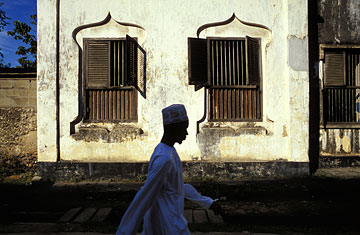
Stone Town charms with its backstreets and doorways, then offers stark reminders of its past
Before globalization, there was trade. Some ports, like Hong Kong or New York, began by handling tea or opium, then progressed to manufacturing and finance. Others, like Alexandria or Pulau Run (one of the Indonesian Spice Islands that, in 1667, the Dutch swapped with the English for Manhattan) failed to move with the times.
In Africa, Durban and Mombasa endured but Goree (Ghana) and Ibo (Mozambique) declined with the end of slavery. Nowhere, though, was harder hit by the end of that terrible trade than Zanzibar. Its former capital, Stone Town, was literally built on slaves: the bones of thousands were encased in the foundations of several buildings in a horrific form of reinforced masonry. But if slavers deserted Zanzibar, the immense houses they built on the backs of their ghastly cargo remain, along with a host of cultural legacies. And that's Stone Town's main draw: the chance to walk through the past. At one time, this was where Africa met Asia, Europe and America, and it shows.
Today, Stone Town is the historic center of the present capital, Zanzibar City, and is a UNESCO World Heritage area. The showpiece is the waterfront, a line of whitewashed palaces and forts beside clear, green waters. Here the British Old Dispensary sits next to Portuguese cannons, a fort built by Omani Arabs, and the Victorian clock tower of the Beit al-Ajaib — the first building in Africa with running water, electricity and a lift.
After a stroll along the promenade, pick an alley heading away from the water and immerse yourself in a warren of ancient caravansaries, markets and wooden balconies under which craftsmen still carve the intricate doors that are Zanzibar's signature decorative form. In the old slave market, you'll find traces of the past as well as of the surprising religious tolerance that slavery was shown: captives were flogged and paraded in the shadow of mosques, cathedrals and Hindu and Buddhist temples.
This is also the place to pick up souvenirs like cotton kanga (sarong-like wraps) as well as antiques, aromatic oils and spices. And there's no need to leave all this history behind to find a place to stay. Try 236 Hurumzi, www.zanzibar.org, a 22-room converted mansion with huge ceilings, ample atmosphere and a tiny rooftop restaurant where guests dine while reclining on pillows. Rooms are from $185 per night. More refined still is the Zanzibar Palace Hotel, www.zanzibarpalacehotel.com, another mansion with nine vast rooms (try the Dunia suite, with a rooftop bath and sundeck). Accommodation starts at $160 per person.
